Social Innovation and Community Engagement for Sunstate Cement Ltd
VerifiedAdded on 2023/06/05
|13
|3230
|164
AI Summary
This paper discusses the concept of social innovation and community engagement, suggests a social innovation for Sunstate cement ltd, and conducts SWOT and PESTLE analysis to identify some of the factors that influence social innovation in this company.
Contribute Materials
Your contribution can guide someone’s learning journey. Share your
documents today.
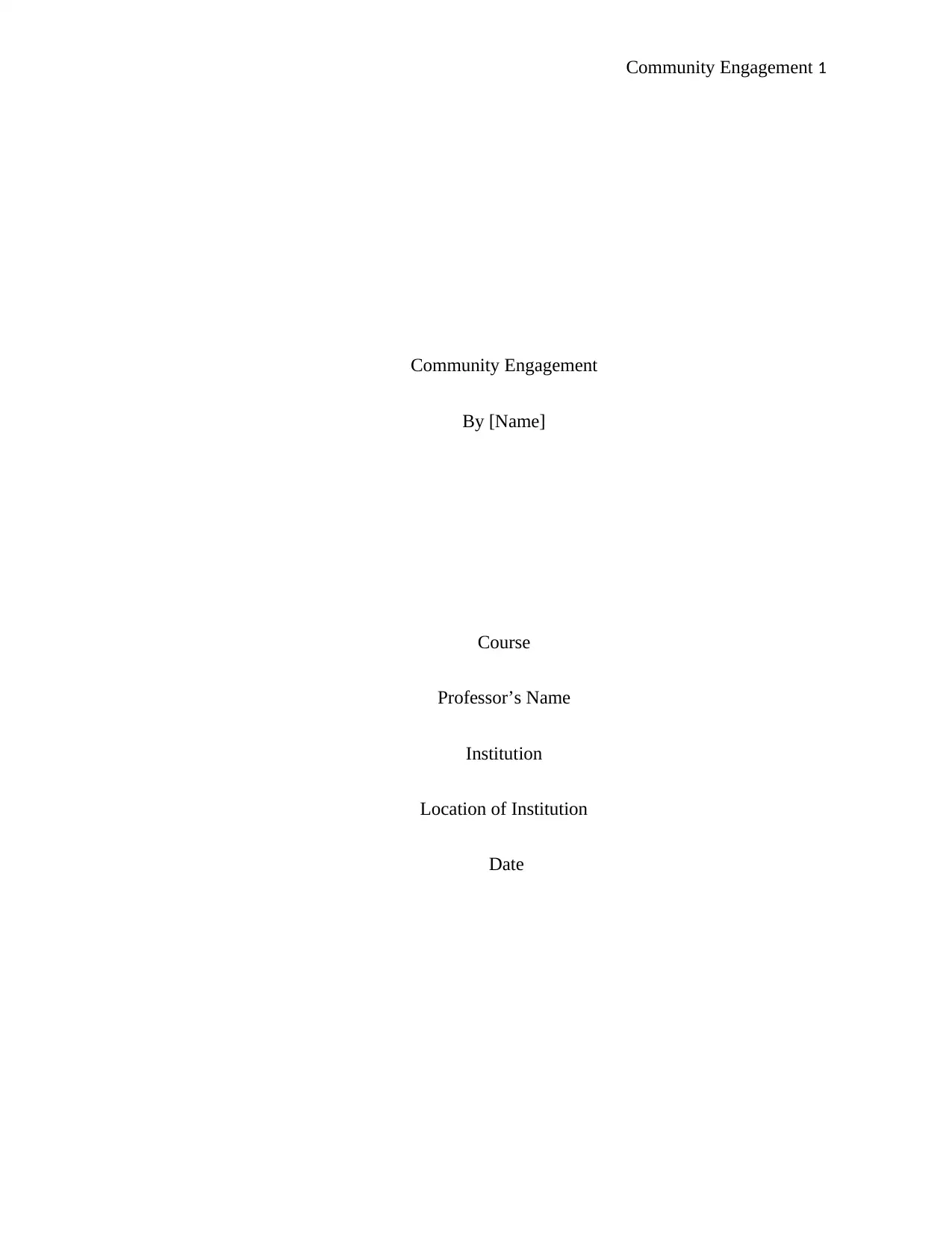
Community Engagement 1
Community Engagement
By [Name]
Course
Professor’s Name
Institution
Location of Institution
Date
Community Engagement
By [Name]
Course
Professor’s Name
Institution
Location of Institution
Date
Secure Best Marks with AI Grader
Need help grading? Try our AI Grader for instant feedback on your assignments.
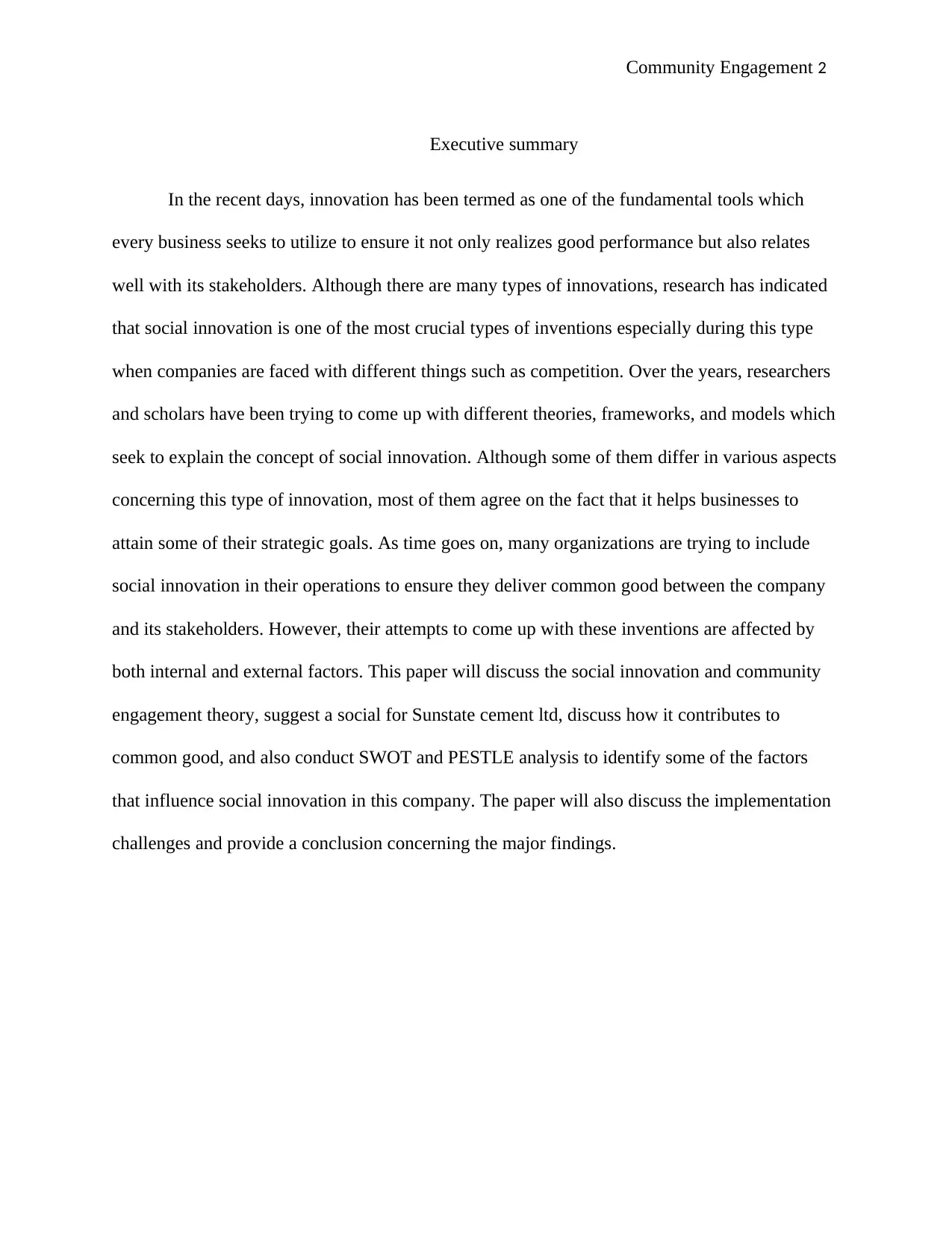
Community Engagement 2
Executive summary
In the recent days, innovation has been termed as one of the fundamental tools which
every business seeks to utilize to ensure it not only realizes good performance but also relates
well with its stakeholders. Although there are many types of innovations, research has indicated
that social innovation is one of the most crucial types of inventions especially during this type
when companies are faced with different things such as competition. Over the years, researchers
and scholars have been trying to come up with different theories, frameworks, and models which
seek to explain the concept of social innovation. Although some of them differ in various aspects
concerning this type of innovation, most of them agree on the fact that it helps businesses to
attain some of their strategic goals. As time goes on, many organizations are trying to include
social innovation in their operations to ensure they deliver common good between the company
and its stakeholders. However, their attempts to come up with these inventions are affected by
both internal and external factors. This paper will discuss the social innovation and community
engagement theory, suggest a social for Sunstate cement ltd, discuss how it contributes to
common good, and also conduct SWOT and PESTLE analysis to identify some of the factors
that influence social innovation in this company. The paper will also discuss the implementation
challenges and provide a conclusion concerning the major findings.
Executive summary
In the recent days, innovation has been termed as one of the fundamental tools which
every business seeks to utilize to ensure it not only realizes good performance but also relates
well with its stakeholders. Although there are many types of innovations, research has indicated
that social innovation is one of the most crucial types of inventions especially during this type
when companies are faced with different things such as competition. Over the years, researchers
and scholars have been trying to come up with different theories, frameworks, and models which
seek to explain the concept of social innovation. Although some of them differ in various aspects
concerning this type of innovation, most of them agree on the fact that it helps businesses to
attain some of their strategic goals. As time goes on, many organizations are trying to include
social innovation in their operations to ensure they deliver common good between the company
and its stakeholders. However, their attempts to come up with these inventions are affected by
both internal and external factors. This paper will discuss the social innovation and community
engagement theory, suggest a social for Sunstate cement ltd, discuss how it contributes to
common good, and also conduct SWOT and PESTLE analysis to identify some of the factors
that influence social innovation in this company. The paper will also discuss the implementation
challenges and provide a conclusion concerning the major findings.
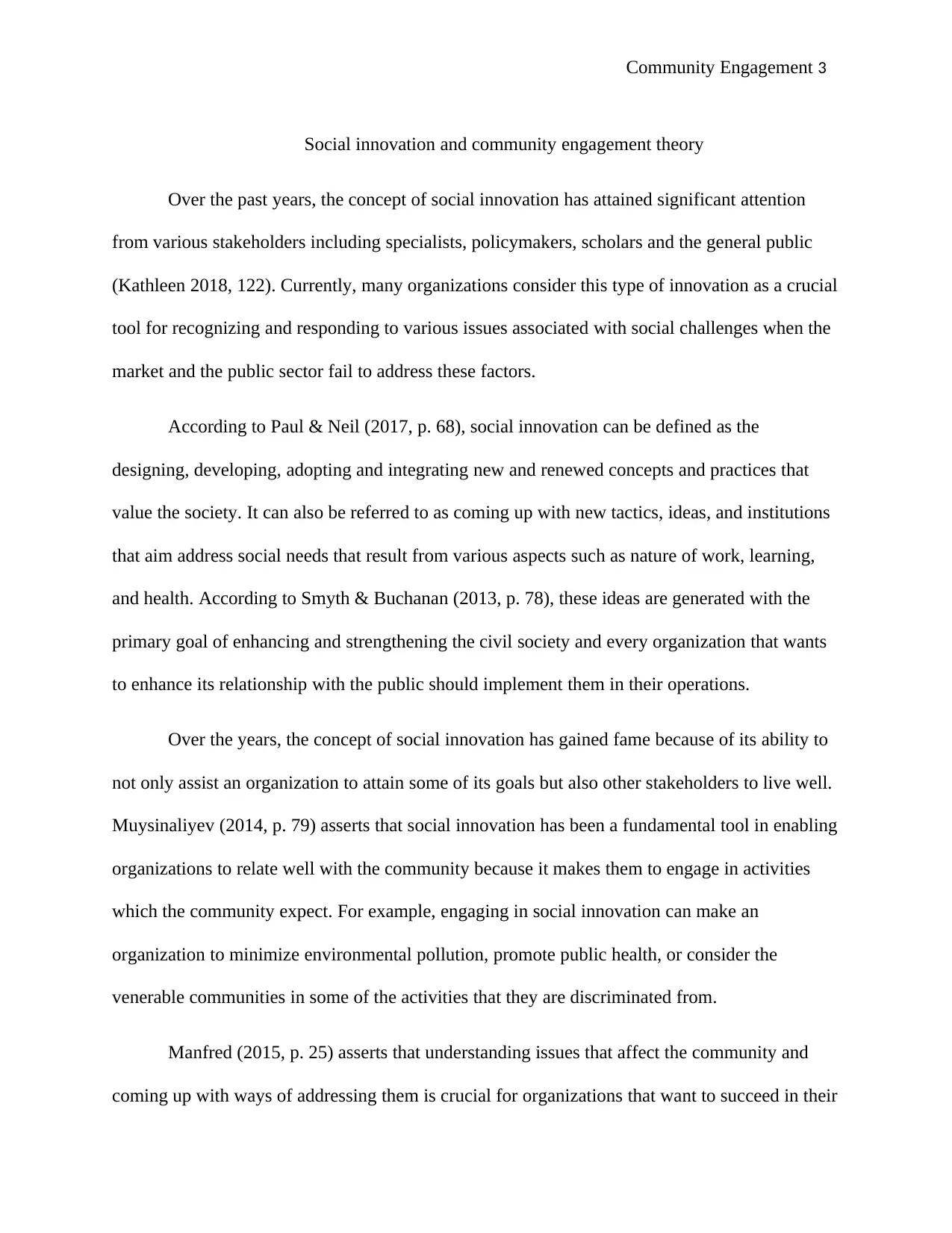
Community Engagement 3
Social innovation and community engagement theory
Over the past years, the concept of social innovation has attained significant attention
from various stakeholders including specialists, policymakers, scholars and the general public
(Kathleen 2018, 122). Currently, many organizations consider this type of innovation as a crucial
tool for recognizing and responding to various issues associated with social challenges when the
market and the public sector fail to address these factors.
According to Paul & Neil (2017, p. 68), social innovation can be defined as the
designing, developing, adopting and integrating new and renewed concepts and practices that
value the society. It can also be referred to as coming up with new tactics, ideas, and institutions
that aim address social needs that result from various aspects such as nature of work, learning,
and health. According to Smyth & Buchanan (2013, p. 78), these ideas are generated with the
primary goal of enhancing and strengthening the civil society and every organization that wants
to enhance its relationship with the public should implement them in their operations.
Over the years, the concept of social innovation has gained fame because of its ability to
not only assist an organization to attain some of its goals but also other stakeholders to live well.
Muysinaliyev (2014, p. 79) asserts that social innovation has been a fundamental tool in enabling
organizations to relate well with the community because it makes them to engage in activities
which the community expect. For example, engaging in social innovation can make an
organization to minimize environmental pollution, promote public health, or consider the
venerable communities in some of the activities that they are discriminated from.
Manfred (2015, p. 25) asserts that understanding issues that affect the community and
coming up with ways of addressing them is crucial for organizations that want to succeed in their
Social innovation and community engagement theory
Over the past years, the concept of social innovation has attained significant attention
from various stakeholders including specialists, policymakers, scholars and the general public
(Kathleen 2018, 122). Currently, many organizations consider this type of innovation as a crucial
tool for recognizing and responding to various issues associated with social challenges when the
market and the public sector fail to address these factors.
According to Paul & Neil (2017, p. 68), social innovation can be defined as the
designing, developing, adopting and integrating new and renewed concepts and practices that
value the society. It can also be referred to as coming up with new tactics, ideas, and institutions
that aim address social needs that result from various aspects such as nature of work, learning,
and health. According to Smyth & Buchanan (2013, p. 78), these ideas are generated with the
primary goal of enhancing and strengthening the civil society and every organization that wants
to enhance its relationship with the public should implement them in their operations.
Over the years, the concept of social innovation has gained fame because of its ability to
not only assist an organization to attain some of its goals but also other stakeholders to live well.
Muysinaliyev (2014, p. 79) asserts that social innovation has been a fundamental tool in enabling
organizations to relate well with the community because it makes them to engage in activities
which the community expect. For example, engaging in social innovation can make an
organization to minimize environmental pollution, promote public health, or consider the
venerable communities in some of the activities that they are discriminated from.
Manfred (2015, p. 25) asserts that understanding issues that affect the community and
coming up with ways of addressing them is crucial for organizations that want to succeed in their
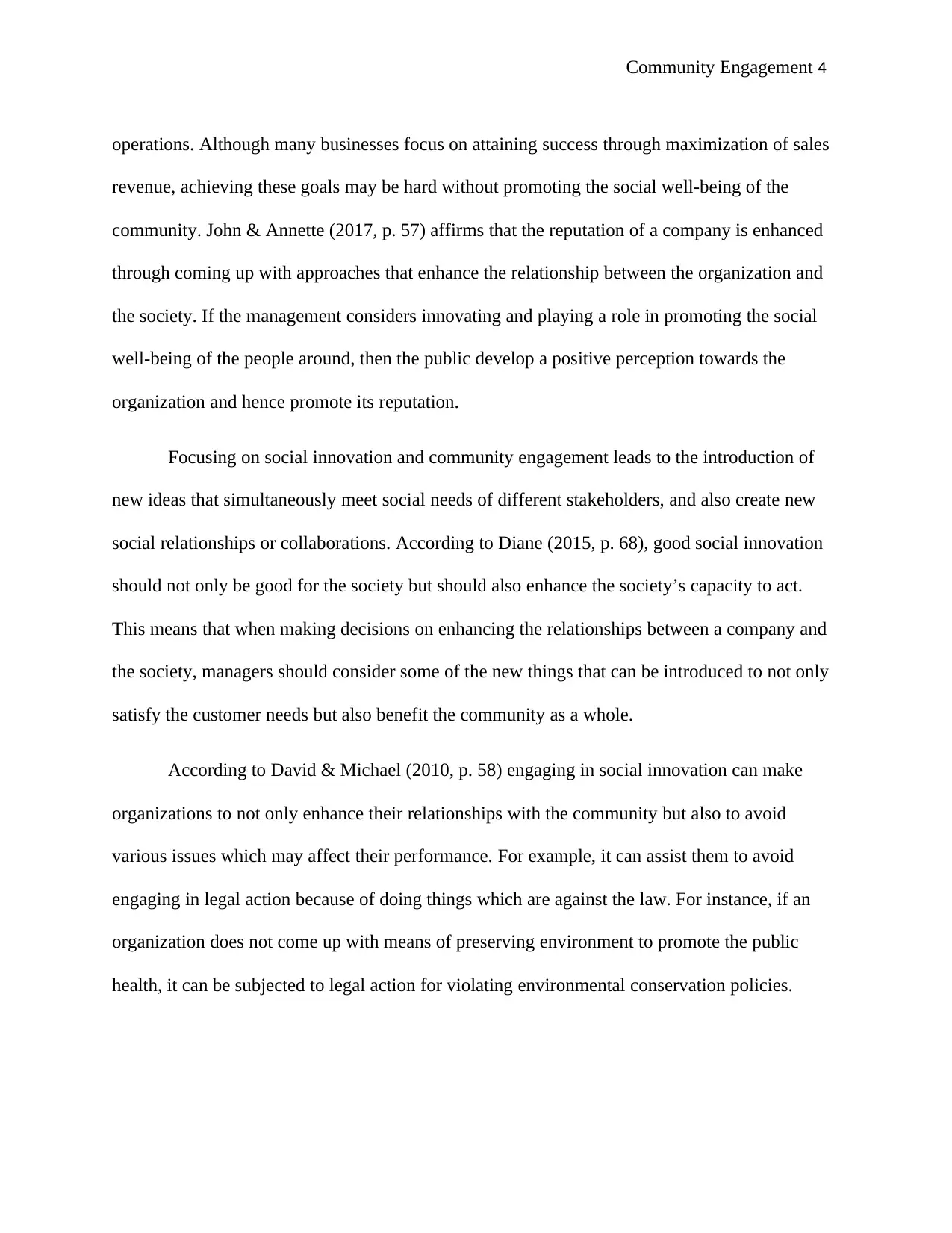
Community Engagement 4
operations. Although many businesses focus on attaining success through maximization of sales
revenue, achieving these goals may be hard without promoting the social well-being of the
community. John & Annette (2017, p. 57) affirms that the reputation of a company is enhanced
through coming up with approaches that enhance the relationship between the organization and
the society. If the management considers innovating and playing a role in promoting the social
well-being of the people around, then the public develop a positive perception towards the
organization and hence promote its reputation.
Focusing on social innovation and community engagement leads to the introduction of
new ideas that simultaneously meet social needs of different stakeholders, and also create new
social relationships or collaborations. According to Diane (2015, p. 68), good social innovation
should not only be good for the society but should also enhance the society’s capacity to act.
This means that when making decisions on enhancing the relationships between a company and
the society, managers should consider some of the new things that can be introduced to not only
satisfy the customer needs but also benefit the community as a whole.
According to David & Michael (2010, p. 58) engaging in social innovation can make
organizations to not only enhance their relationships with the community but also to avoid
various issues which may affect their performance. For example, it can assist them to avoid
engaging in legal action because of doing things which are against the law. For instance, if an
organization does not come up with means of preserving environment to promote the public
health, it can be subjected to legal action for violating environmental conservation policies.
operations. Although many businesses focus on attaining success through maximization of sales
revenue, achieving these goals may be hard without promoting the social well-being of the
community. John & Annette (2017, p. 57) affirms that the reputation of a company is enhanced
through coming up with approaches that enhance the relationship between the organization and
the society. If the management considers innovating and playing a role in promoting the social
well-being of the people around, then the public develop a positive perception towards the
organization and hence promote its reputation.
Focusing on social innovation and community engagement leads to the introduction of
new ideas that simultaneously meet social needs of different stakeholders, and also create new
social relationships or collaborations. According to Diane (2015, p. 68), good social innovation
should not only be good for the society but should also enhance the society’s capacity to act.
This means that when making decisions on enhancing the relationships between a company and
the society, managers should consider some of the new things that can be introduced to not only
satisfy the customer needs but also benefit the community as a whole.
According to David & Michael (2010, p. 58) engaging in social innovation can make
organizations to not only enhance their relationships with the community but also to avoid
various issues which may affect their performance. For example, it can assist them to avoid
engaging in legal action because of doing things which are against the law. For instance, if an
organization does not come up with means of preserving environment to promote the public
health, it can be subjected to legal action for violating environmental conservation policies.
Secure Best Marks with AI Grader
Need help grading? Try our AI Grader for instant feedback on your assignments.
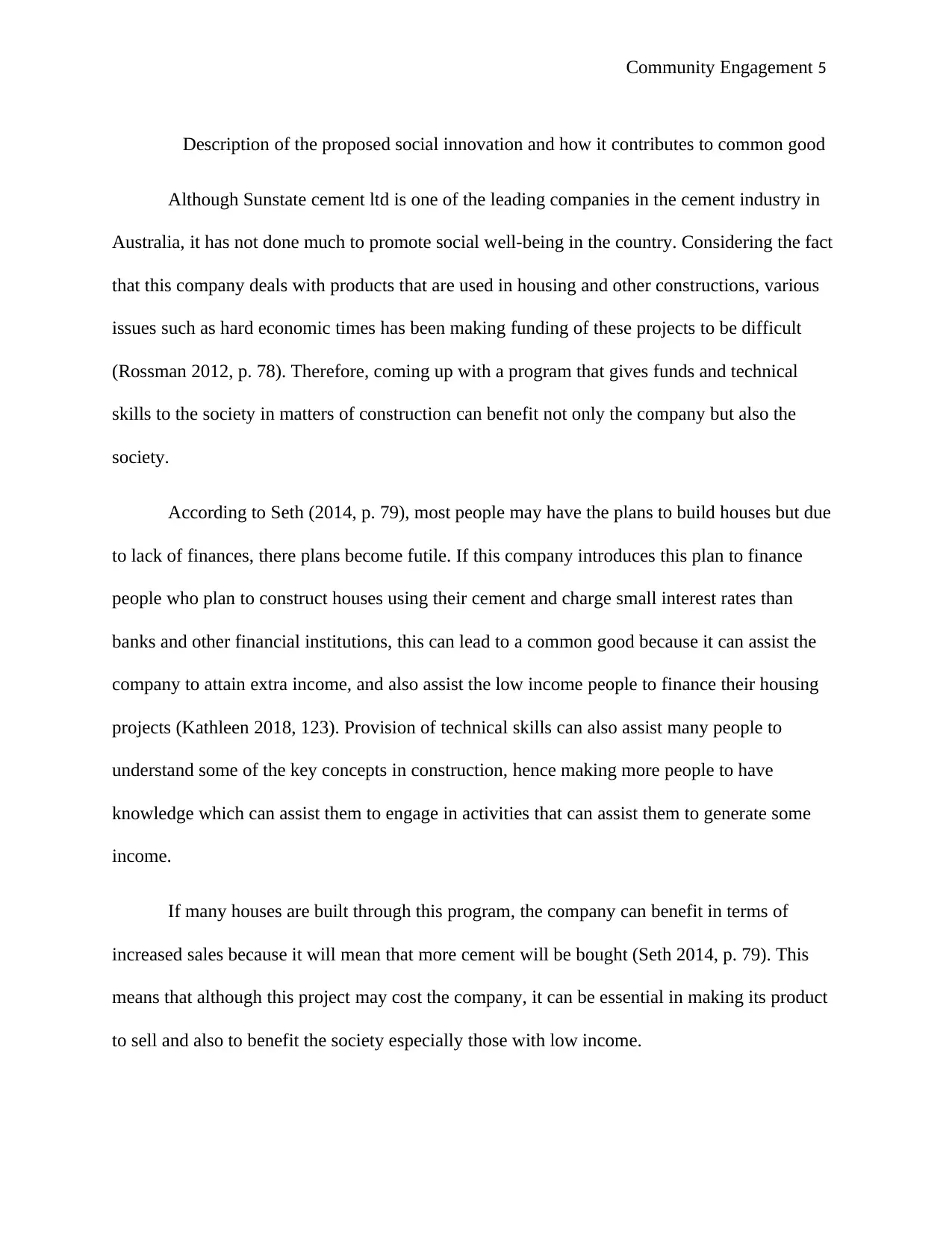
Community Engagement 5
Description of the proposed social innovation and how it contributes to common good
Although Sunstate cement ltd is one of the leading companies in the cement industry in
Australia, it has not done much to promote social well-being in the country. Considering the fact
that this company deals with products that are used in housing and other constructions, various
issues such as hard economic times has been making funding of these projects to be difficult
(Rossman 2012, p. 78). Therefore, coming up with a program that gives funds and technical
skills to the society in matters of construction can benefit not only the company but also the
society.
According to Seth (2014, p. 79), most people may have the plans to build houses but due
to lack of finances, there plans become futile. If this company introduces this plan to finance
people who plan to construct houses using their cement and charge small interest rates than
banks and other financial institutions, this can lead to a common good because it can assist the
company to attain extra income, and also assist the low income people to finance their housing
projects (Kathleen 2018, 123). Provision of technical skills can also assist many people to
understand some of the key concepts in construction, hence making more people to have
knowledge which can assist them to engage in activities that can assist them to generate some
income.
If many houses are built through this program, the company can benefit in terms of
increased sales because it will mean that more cement will be bought (Seth 2014, p. 79). This
means that although this project may cost the company, it can be essential in making its product
to sell and also to benefit the society especially those with low income.
Description of the proposed social innovation and how it contributes to common good
Although Sunstate cement ltd is one of the leading companies in the cement industry in
Australia, it has not done much to promote social well-being in the country. Considering the fact
that this company deals with products that are used in housing and other constructions, various
issues such as hard economic times has been making funding of these projects to be difficult
(Rossman 2012, p. 78). Therefore, coming up with a program that gives funds and technical
skills to the society in matters of construction can benefit not only the company but also the
society.
According to Seth (2014, p. 79), most people may have the plans to build houses but due
to lack of finances, there plans become futile. If this company introduces this plan to finance
people who plan to construct houses using their cement and charge small interest rates than
banks and other financial institutions, this can lead to a common good because it can assist the
company to attain extra income, and also assist the low income people to finance their housing
projects (Kathleen 2018, 123). Provision of technical skills can also assist many people to
understand some of the key concepts in construction, hence making more people to have
knowledge which can assist them to engage in activities that can assist them to generate some
income.
If many houses are built through this program, the company can benefit in terms of
increased sales because it will mean that more cement will be bought (Seth 2014, p. 79). This
means that although this project may cost the company, it can be essential in making its product
to sell and also to benefit the society especially those with low income.
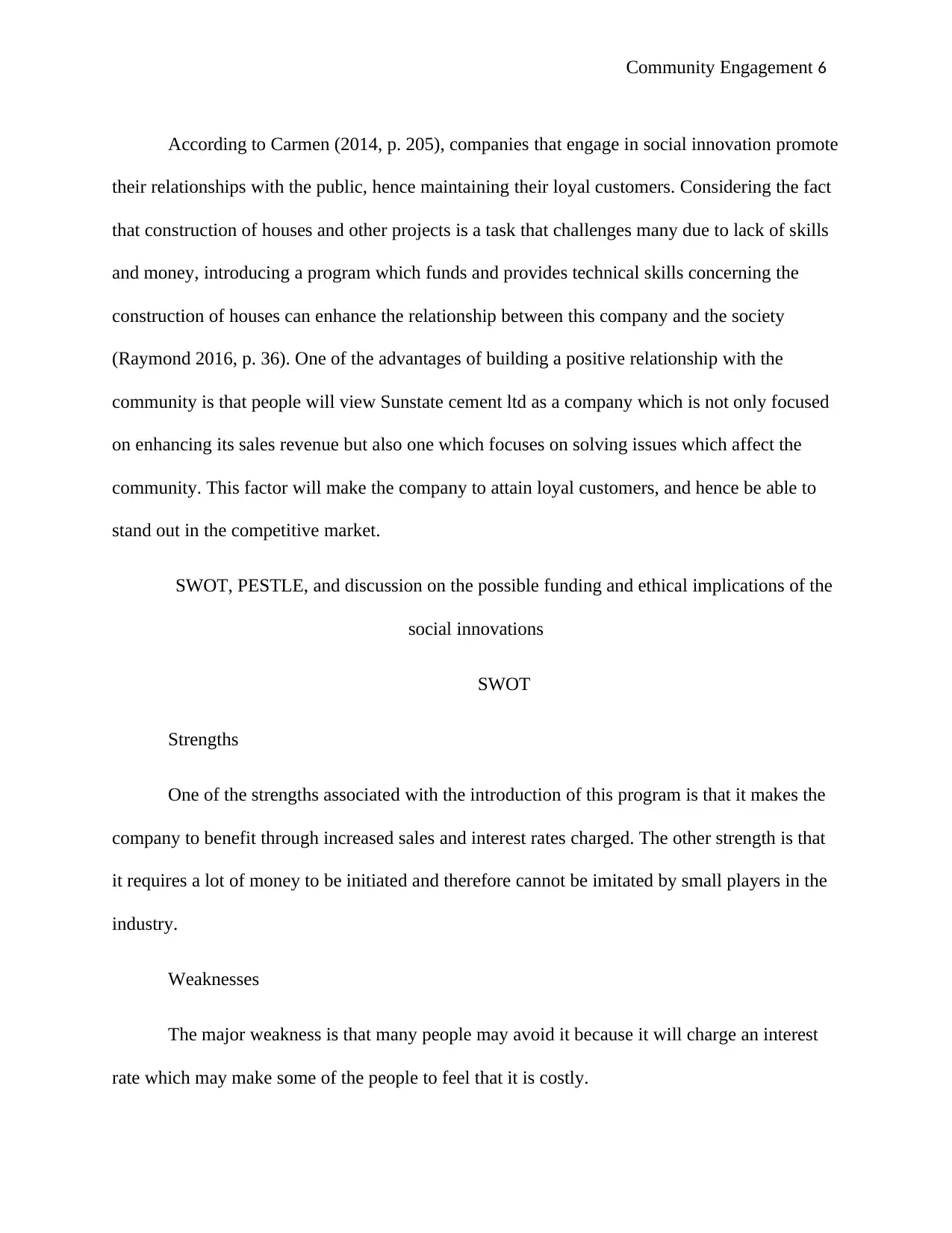
Community Engagement 6
According to Carmen (2014, p. 205), companies that engage in social innovation promote
their relationships with the public, hence maintaining their loyal customers. Considering the fact
that construction of houses and other projects is a task that challenges many due to lack of skills
and money, introducing a program which funds and provides technical skills concerning the
construction of houses can enhance the relationship between this company and the society
(Raymond 2016, p. 36). One of the advantages of building a positive relationship with the
community is that people will view Sunstate cement ltd as a company which is not only focused
on enhancing its sales revenue but also one which focuses on solving issues which affect the
community. This factor will make the company to attain loyal customers, and hence be able to
stand out in the competitive market.
SWOT, PESTLE, and discussion on the possible funding and ethical implications of the
social innovations
SWOT
Strengths
One of the strengths associated with the introduction of this program is that it makes the
company to benefit through increased sales and interest rates charged. The other strength is that
it requires a lot of money to be initiated and therefore cannot be imitated by small players in the
industry.
Weaknesses
The major weakness is that many people may avoid it because it will charge an interest
rate which may make some of the people to feel that it is costly.
According to Carmen (2014, p. 205), companies that engage in social innovation promote
their relationships with the public, hence maintaining their loyal customers. Considering the fact
that construction of houses and other projects is a task that challenges many due to lack of skills
and money, introducing a program which funds and provides technical skills concerning the
construction of houses can enhance the relationship between this company and the society
(Raymond 2016, p. 36). One of the advantages of building a positive relationship with the
community is that people will view Sunstate cement ltd as a company which is not only focused
on enhancing its sales revenue but also one which focuses on solving issues which affect the
community. This factor will make the company to attain loyal customers, and hence be able to
stand out in the competitive market.
SWOT, PESTLE, and discussion on the possible funding and ethical implications of the
social innovations
SWOT
Strengths
One of the strengths associated with the introduction of this program is that it makes the
company to benefit through increased sales and interest rates charged. The other strength is that
it requires a lot of money to be initiated and therefore cannot be imitated by small players in the
industry.
Weaknesses
The major weakness is that many people may avoid it because it will charge an interest
rate which may make some of the people to feel that it is costly.
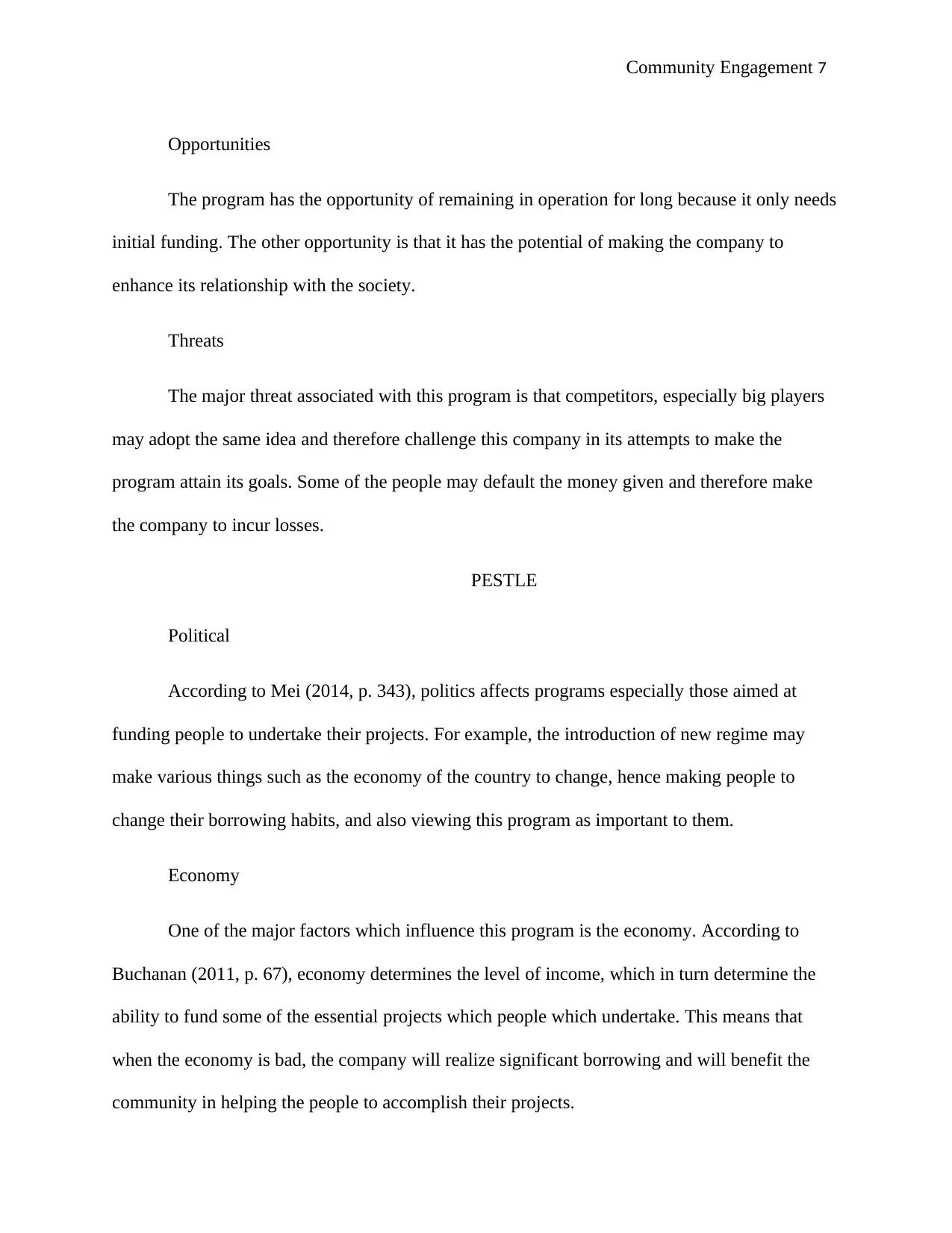
Community Engagement 7
Opportunities
The program has the opportunity of remaining in operation for long because it only needs
initial funding. The other opportunity is that it has the potential of making the company to
enhance its relationship with the society.
Threats
The major threat associated with this program is that competitors, especially big players
may adopt the same idea and therefore challenge this company in its attempts to make the
program attain its goals. Some of the people may default the money given and therefore make
the company to incur losses.
PESTLE
Political
According to Mei (2014, p. 343), politics affects programs especially those aimed at
funding people to undertake their projects. For example, the introduction of new regime may
make various things such as the economy of the country to change, hence making people to
change their borrowing habits, and also viewing this program as important to them.
Economy
One of the major factors which influence this program is the economy. According to
Buchanan (2011, p. 67), economy determines the level of income, which in turn determine the
ability to fund some of the essential projects which people which undertake. This means that
when the economy is bad, the company will realize significant borrowing and will benefit the
community in helping the people to accomplish their projects.
Opportunities
The program has the opportunity of remaining in operation for long because it only needs
initial funding. The other opportunity is that it has the potential of making the company to
enhance its relationship with the society.
Threats
The major threat associated with this program is that competitors, especially big players
may adopt the same idea and therefore challenge this company in its attempts to make the
program attain its goals. Some of the people may default the money given and therefore make
the company to incur losses.
PESTLE
Political
According to Mei (2014, p. 343), politics affects programs especially those aimed at
funding people to undertake their projects. For example, the introduction of new regime may
make various things such as the economy of the country to change, hence making people to
change their borrowing habits, and also viewing this program as important to them.
Economy
One of the major factors which influence this program is the economy. According to
Buchanan (2011, p. 67), economy determines the level of income, which in turn determine the
ability to fund some of the essential projects which people which undertake. This means that
when the economy is bad, the company will realize significant borrowing and will benefit the
community in helping the people to accomplish their projects.
Paraphrase This Document
Need a fresh take? Get an instant paraphrase of this document with our AI Paraphraser
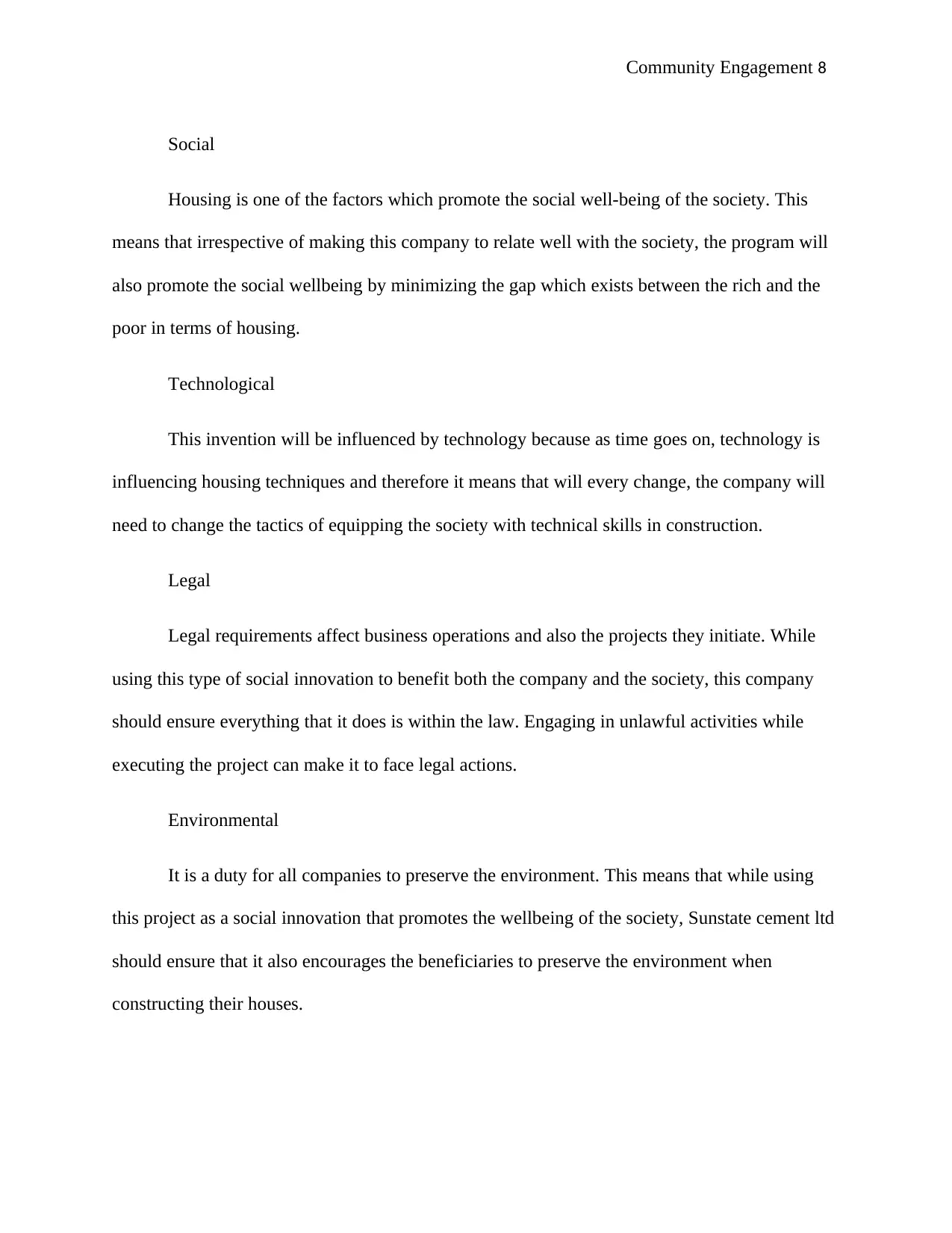
Community Engagement 8
Social
Housing is one of the factors which promote the social well-being of the society. This
means that irrespective of making this company to relate well with the society, the program will
also promote the social wellbeing by minimizing the gap which exists between the rich and the
poor in terms of housing.
Technological
This invention will be influenced by technology because as time goes on, technology is
influencing housing techniques and therefore it means that will every change, the company will
need to change the tactics of equipping the society with technical skills in construction.
Legal
Legal requirements affect business operations and also the projects they initiate. While
using this type of social innovation to benefit both the company and the society, this company
should ensure everything that it does is within the law. Engaging in unlawful activities while
executing the project can make it to face legal actions.
Environmental
It is a duty for all companies to preserve the environment. This means that while using
this project as a social innovation that promotes the wellbeing of the society, Sunstate cement ltd
should ensure that it also encourages the beneficiaries to preserve the environment when
constructing their houses.
Social
Housing is one of the factors which promote the social well-being of the society. This
means that irrespective of making this company to relate well with the society, the program will
also promote the social wellbeing by minimizing the gap which exists between the rich and the
poor in terms of housing.
Technological
This invention will be influenced by technology because as time goes on, technology is
influencing housing techniques and therefore it means that will every change, the company will
need to change the tactics of equipping the society with technical skills in construction.
Legal
Legal requirements affect business operations and also the projects they initiate. While
using this type of social innovation to benefit both the company and the society, this company
should ensure everything that it does is within the law. Engaging in unlawful activities while
executing the project can make it to face legal actions.
Environmental
It is a duty for all companies to preserve the environment. This means that while using
this project as a social innovation that promotes the wellbeing of the society, Sunstate cement ltd
should ensure that it also encourages the beneficiaries to preserve the environment when
constructing their houses.
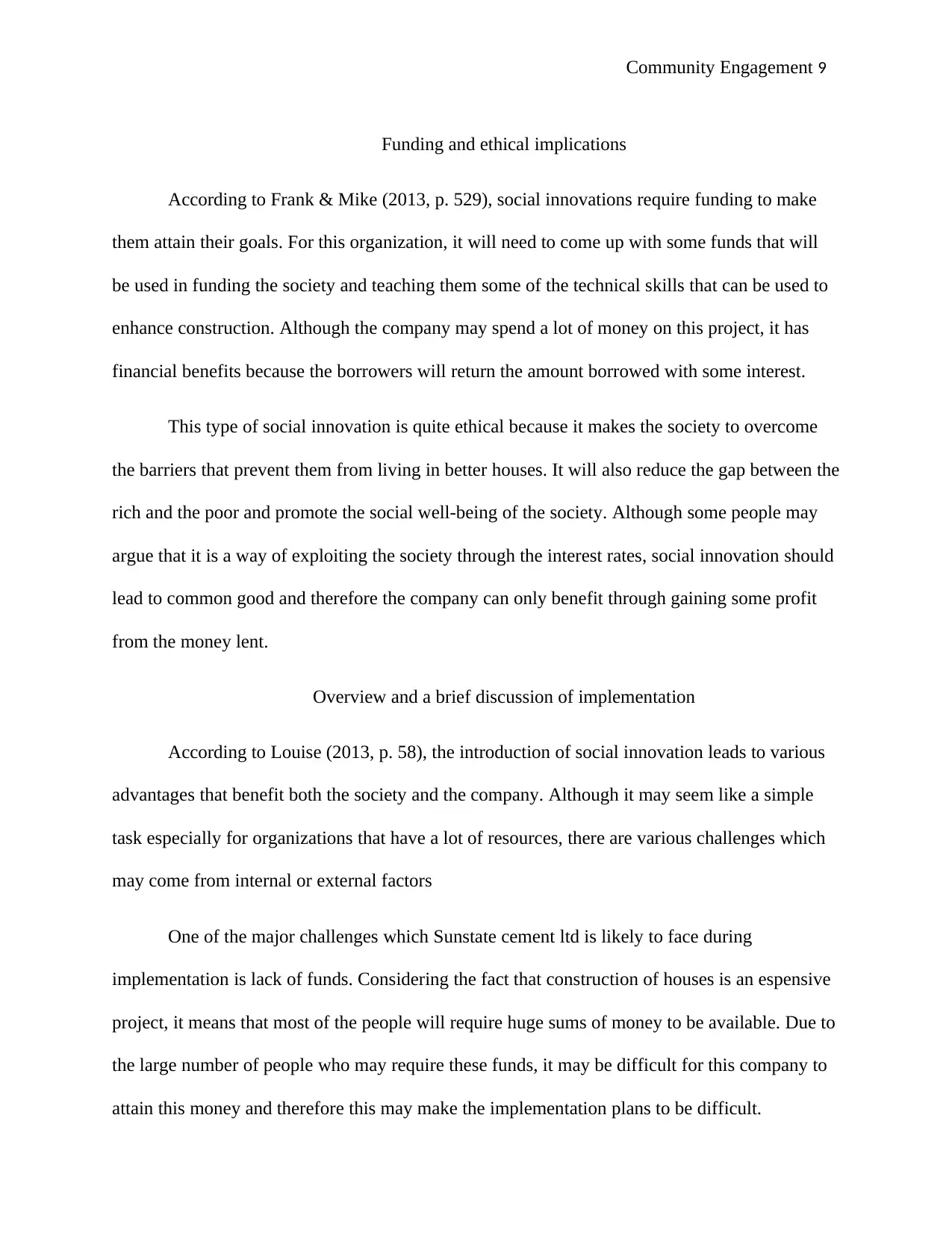
Community Engagement 9
Funding and ethical implications
According to Frank & Mike (2013, p. 529), social innovations require funding to make
them attain their goals. For this organization, it will need to come up with some funds that will
be used in funding the society and teaching them some of the technical skills that can be used to
enhance construction. Although the company may spend a lot of money on this project, it has
financial benefits because the borrowers will return the amount borrowed with some interest.
This type of social innovation is quite ethical because it makes the society to overcome
the barriers that prevent them from living in better houses. It will also reduce the gap between the
rich and the poor and promote the social well-being of the society. Although some people may
argue that it is a way of exploiting the society through the interest rates, social innovation should
lead to common good and therefore the company can only benefit through gaining some profit
from the money lent.
Overview and a brief discussion of implementation
According to Louise (2013, p. 58), the introduction of social innovation leads to various
advantages that benefit both the society and the company. Although it may seem like a simple
task especially for organizations that have a lot of resources, there are various challenges which
may come from internal or external factors
One of the major challenges which Sunstate cement ltd is likely to face during
implementation is lack of funds. Considering the fact that construction of houses is an espensive
project, it means that most of the people will require huge sums of money to be available. Due to
the large number of people who may require these funds, it may be difficult for this company to
attain this money and therefore this may make the implementation plans to be difficult.
Funding and ethical implications
According to Frank & Mike (2013, p. 529), social innovations require funding to make
them attain their goals. For this organization, it will need to come up with some funds that will
be used in funding the society and teaching them some of the technical skills that can be used to
enhance construction. Although the company may spend a lot of money on this project, it has
financial benefits because the borrowers will return the amount borrowed with some interest.
This type of social innovation is quite ethical because it makes the society to overcome
the barriers that prevent them from living in better houses. It will also reduce the gap between the
rich and the poor and promote the social well-being of the society. Although some people may
argue that it is a way of exploiting the society through the interest rates, social innovation should
lead to common good and therefore the company can only benefit through gaining some profit
from the money lent.
Overview and a brief discussion of implementation
According to Louise (2013, p. 58), the introduction of social innovation leads to various
advantages that benefit both the society and the company. Although it may seem like a simple
task especially for organizations that have a lot of resources, there are various challenges which
may come from internal or external factors
One of the major challenges which Sunstate cement ltd is likely to face during
implementation is lack of funds. Considering the fact that construction of houses is an espensive
project, it means that most of the people will require huge sums of money to be available. Due to
the large number of people who may require these funds, it may be difficult for this company to
attain this money and therefore this may make the implementation plans to be difficult.
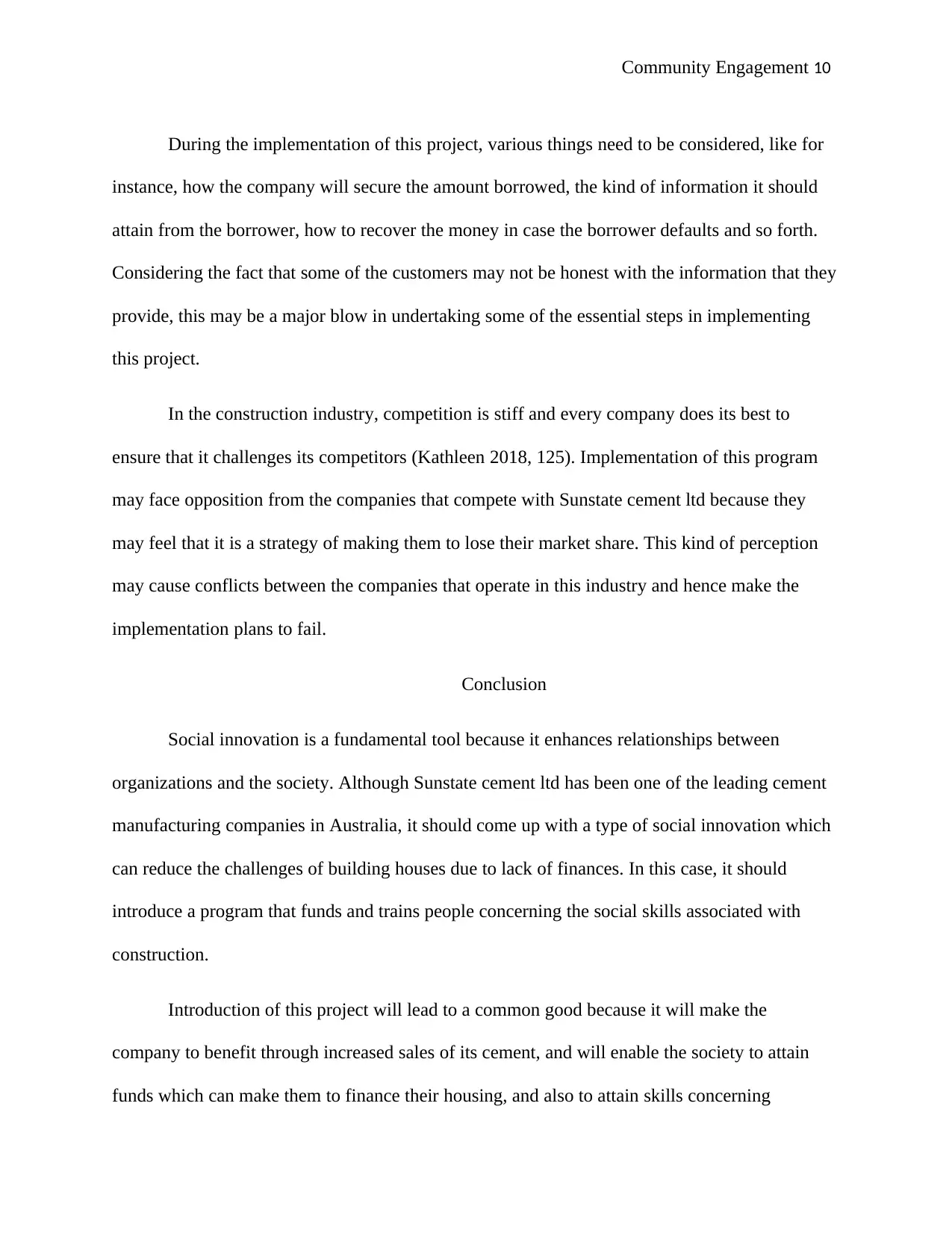
Community Engagement 10
During the implementation of this project, various things need to be considered, like for
instance, how the company will secure the amount borrowed, the kind of information it should
attain from the borrower, how to recover the money in case the borrower defaults and so forth.
Considering the fact that some of the customers may not be honest with the information that they
provide, this may be a major blow in undertaking some of the essential steps in implementing
this project.
In the construction industry, competition is stiff and every company does its best to
ensure that it challenges its competitors (Kathleen 2018, 125). Implementation of this program
may face opposition from the companies that compete with Sunstate cement ltd because they
may feel that it is a strategy of making them to lose their market share. This kind of perception
may cause conflicts between the companies that operate in this industry and hence make the
implementation plans to fail.
Conclusion
Social innovation is a fundamental tool because it enhances relationships between
organizations and the society. Although Sunstate cement ltd has been one of the leading cement
manufacturing companies in Australia, it should come up with a type of social innovation which
can reduce the challenges of building houses due to lack of finances. In this case, it should
introduce a program that funds and trains people concerning the social skills associated with
construction.
Introduction of this project will lead to a common good because it will make the
company to benefit through increased sales of its cement, and will enable the society to attain
funds which can make them to finance their housing, and also to attain skills concerning
During the implementation of this project, various things need to be considered, like for
instance, how the company will secure the amount borrowed, the kind of information it should
attain from the borrower, how to recover the money in case the borrower defaults and so forth.
Considering the fact that some of the customers may not be honest with the information that they
provide, this may be a major blow in undertaking some of the essential steps in implementing
this project.
In the construction industry, competition is stiff and every company does its best to
ensure that it challenges its competitors (Kathleen 2018, 125). Implementation of this program
may face opposition from the companies that compete with Sunstate cement ltd because they
may feel that it is a strategy of making them to lose their market share. This kind of perception
may cause conflicts between the companies that operate in this industry and hence make the
implementation plans to fail.
Conclusion
Social innovation is a fundamental tool because it enhances relationships between
organizations and the society. Although Sunstate cement ltd has been one of the leading cement
manufacturing companies in Australia, it should come up with a type of social innovation which
can reduce the challenges of building houses due to lack of finances. In this case, it should
introduce a program that funds and trains people concerning the social skills associated with
construction.
Introduction of this project will lead to a common good because it will make the
company to benefit through increased sales of its cement, and will enable the society to attain
funds which can make them to finance their housing, and also to attain skills concerning
Secure Best Marks with AI Grader
Need help grading? Try our AI Grader for instant feedback on your assignments.

Community Engagement 11
construction. Some of the challenges that can be realized in this social innovation include lack of
funds, lack of trust from the borrowers and opposition from competitors.
construction. Some of the challenges that can be realized in this social innovation include lack of
funds, lack of trust from the borrowers and opposition from competitors.
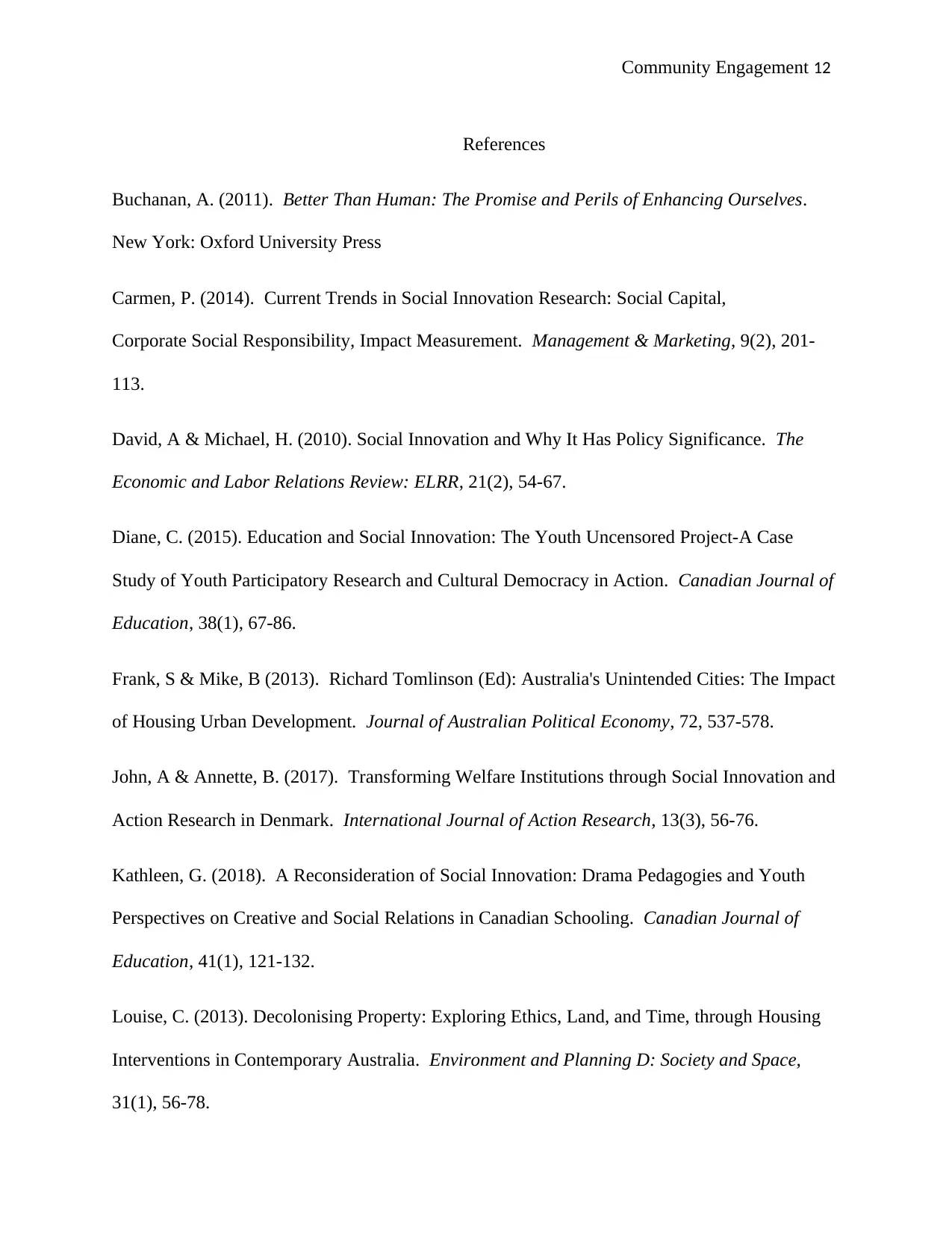
Community Engagement 12
References
Buchanan, A. (2011). Better Than Human: The Promise and Perils of Enhancing Ourselves.
New York: Oxford University Press
Carmen, P. (2014). Current Trends in Social Innovation Research: Social Capital,
Corporate Social Responsibility, Impact Measurement. Management & Marketing, 9(2), 201-
113.
David, A & Michael, H. (2010). Social Innovation and Why It Has Policy Significance. The
Economic and Labor Relations Review: ELRR, 21(2), 54-67.
Diane, C. (2015). Education and Social Innovation: The Youth Uncensored Project-A Case
Study of Youth Participatory Research and Cultural Democracy in Action. Canadian Journal of
Education, 38(1), 67-86.
Frank, S & Mike, B (2013). Richard Tomlinson (Ed): Australia's Unintended Cities: The Impact
of Housing Urban Development. Journal of Australian Political Economy, 72, 537-578.
John, A & Annette, B. (2017). Transforming Welfare Institutions through Social Innovation and
Action Research in Denmark. International Journal of Action Research, 13(3), 56-76.
Kathleen, G. (2018). A Reconsideration of Social Innovation: Drama Pedagogies and Youth
Perspectives on Creative and Social Relations in Canadian Schooling. Canadian Journal of
Education, 41(1), 121-132.
Louise, C. (2013). Decolonising Property: Exploring Ethics, Land, and Time, through Housing
Interventions in Contemporary Australia. Environment and Planning D: Society and Space,
31(1), 56-78.
References
Buchanan, A. (2011). Better Than Human: The Promise and Perils of Enhancing Ourselves.
New York: Oxford University Press
Carmen, P. (2014). Current Trends in Social Innovation Research: Social Capital,
Corporate Social Responsibility, Impact Measurement. Management & Marketing, 9(2), 201-
113.
David, A & Michael, H. (2010). Social Innovation and Why It Has Policy Significance. The
Economic and Labor Relations Review: ELRR, 21(2), 54-67.
Diane, C. (2015). Education and Social Innovation: The Youth Uncensored Project-A Case
Study of Youth Participatory Research and Cultural Democracy in Action. Canadian Journal of
Education, 38(1), 67-86.
Frank, S & Mike, B (2013). Richard Tomlinson (Ed): Australia's Unintended Cities: The Impact
of Housing Urban Development. Journal of Australian Political Economy, 72, 537-578.
John, A & Annette, B. (2017). Transforming Welfare Institutions through Social Innovation and
Action Research in Denmark. International Journal of Action Research, 13(3), 56-76.
Kathleen, G. (2018). A Reconsideration of Social Innovation: Drama Pedagogies and Youth
Perspectives on Creative and Social Relations in Canadian Schooling. Canadian Journal of
Education, 41(1), 121-132.
Louise, C. (2013). Decolonising Property: Exploring Ethics, Land, and Time, through Housing
Interventions in Contemporary Australia. Environment and Planning D: Society and Space,
31(1), 56-78.
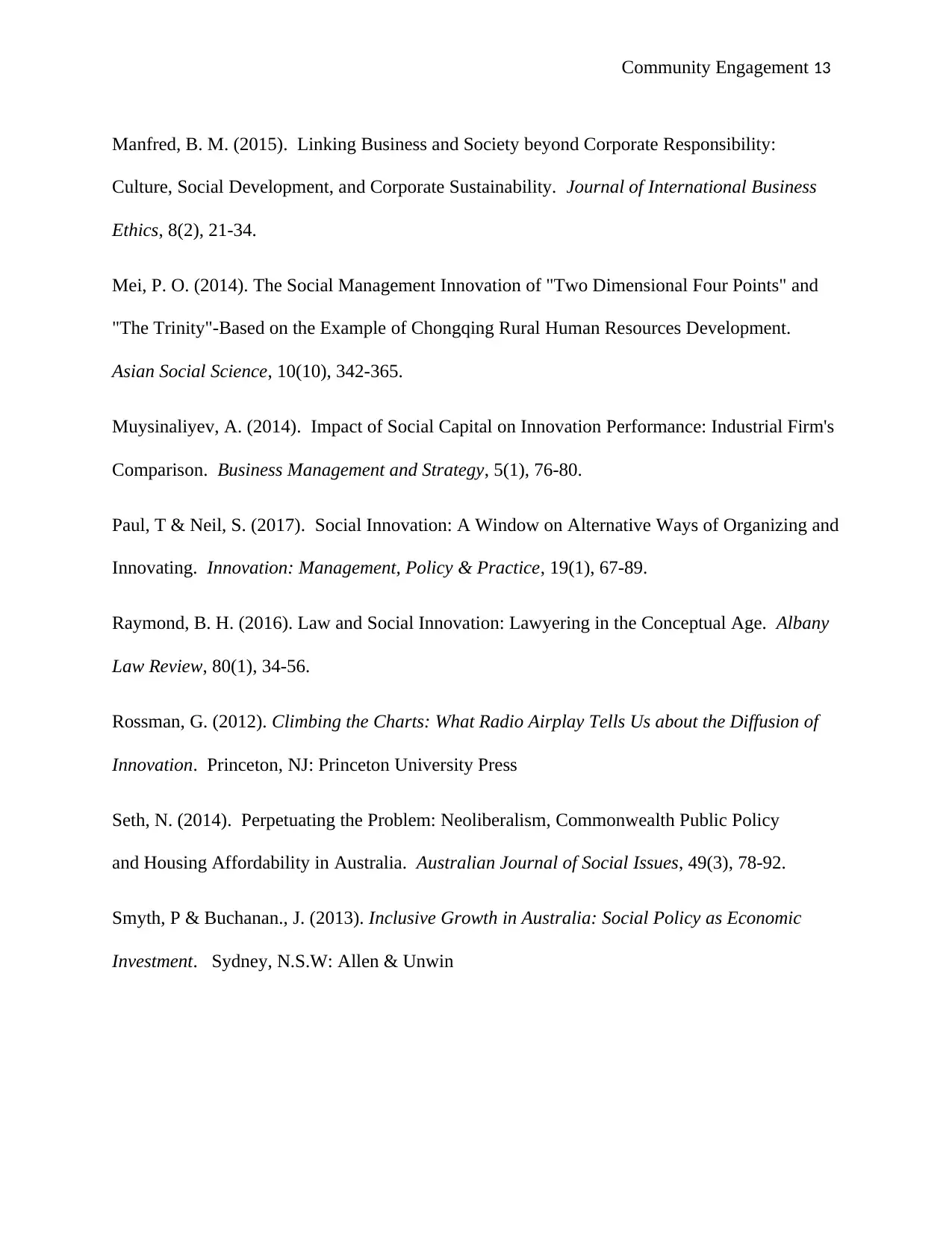
Community Engagement 13
Manfred, B. M. (2015). Linking Business and Society beyond Corporate Responsibility:
Culture, Social Development, and Corporate Sustainability. Journal of International Business
Ethics, 8(2), 21-34.
Mei, P. O. (2014). The Social Management Innovation of "Two Dimensional Four Points" and
"The Trinity"-Based on the Example of Chongqing Rural Human Resources Development.
Asian Social Science, 10(10), 342-365.
Muysinaliyev, A. (2014). Impact of Social Capital on Innovation Performance: Industrial Firm's
Comparison. Business Management and Strategy, 5(1), 76-80.
Paul, T & Neil, S. (2017). Social Innovation: A Window on Alternative Ways of Organizing and
Innovating. Innovation: Management, Policy & Practice, 19(1), 67-89.
Raymond, B. H. (2016). Law and Social Innovation: Lawyering in the Conceptual Age. Albany
Law Review, 80(1), 34-56.
Rossman, G. (2012). Climbing the Charts: What Radio Airplay Tells Us about the Diffusion of
Innovation. Princeton, NJ: Princeton University Press
Seth, N. (2014). Perpetuating the Problem: Neoliberalism, Commonwealth Public Policy
and Housing Affordability in Australia. Australian Journal of Social Issues, 49(3), 78-92.
Smyth, P & Buchanan., J. (2013). Inclusive Growth in Australia: Social Policy as Economic
Investment. Sydney, N.S.W: Allen & Unwin
Manfred, B. M. (2015). Linking Business and Society beyond Corporate Responsibility:
Culture, Social Development, and Corporate Sustainability. Journal of International Business
Ethics, 8(2), 21-34.
Mei, P. O. (2014). The Social Management Innovation of "Two Dimensional Four Points" and
"The Trinity"-Based on the Example of Chongqing Rural Human Resources Development.
Asian Social Science, 10(10), 342-365.
Muysinaliyev, A. (2014). Impact of Social Capital on Innovation Performance: Industrial Firm's
Comparison. Business Management and Strategy, 5(1), 76-80.
Paul, T & Neil, S. (2017). Social Innovation: A Window on Alternative Ways of Organizing and
Innovating. Innovation: Management, Policy & Practice, 19(1), 67-89.
Raymond, B. H. (2016). Law and Social Innovation: Lawyering in the Conceptual Age. Albany
Law Review, 80(1), 34-56.
Rossman, G. (2012). Climbing the Charts: What Radio Airplay Tells Us about the Diffusion of
Innovation. Princeton, NJ: Princeton University Press
Seth, N. (2014). Perpetuating the Problem: Neoliberalism, Commonwealth Public Policy
and Housing Affordability in Australia. Australian Journal of Social Issues, 49(3), 78-92.
Smyth, P & Buchanan., J. (2013). Inclusive Growth in Australia: Social Policy as Economic
Investment. Sydney, N.S.W: Allen & Unwin
1 out of 13
Related Documents
Your All-in-One AI-Powered Toolkit for Academic Success.
+13062052269
info@desklib.com
Available 24*7 on WhatsApp / Email
![[object Object]](/_next/static/media/star-bottom.7253800d.svg)
Unlock your academic potential
© 2024 | Zucol Services PVT LTD | All rights reserved.




